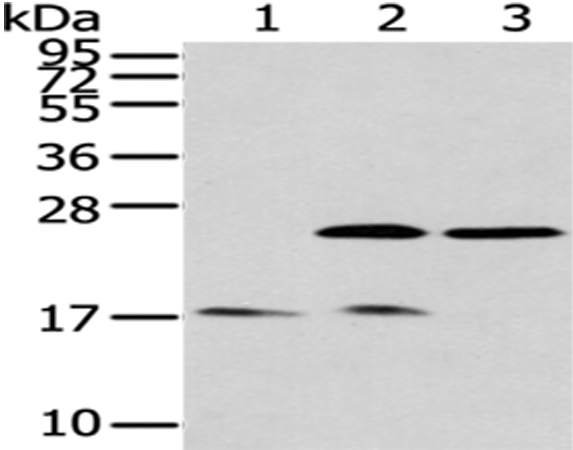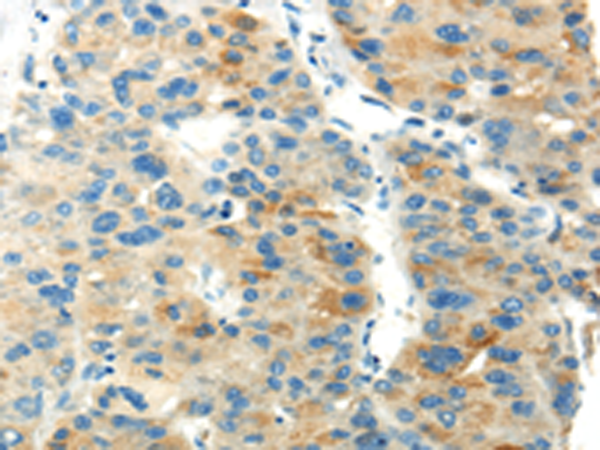

| WB | 咨询技术 | Human,Mouse,Rat |
| IF | 咨询技术 | Human,Mouse,Rat |
| IHC | 1/10-1/50 | Human,Mouse,Rat |
| ICC | 技术咨询 | Human,Mouse,Rat |
| FCM | 咨询技术 | Human,Mouse,Rat |
| Elisa | 1/1000-1/2000 | Human,Mouse,Rat |
| Aliases | T1A; GP36; GP40; Gp38; OTS8; T1A2; TI1A; T1A-2; AGGRUS; HT1A-1; PA2.26 |
| WB Predicted band size | 17 kDa; 25 kDa |
| Host/Isotype | Rabbit IgG |
| Antibody Type | Primary antibody |
| Storage | Store at 4°C short term. Aliquot and store at -20°C long term. Avoid freeze/thaw cycles. |
| Species Reactivity | Human |
| Immunogen | Synthetic peptide of human PDPN |
| Formulation | Purified antibody in PBS with 0.05% sodium azide and 50% glycerol. |
+ +
以下是3篇与PDPN(Podoplanin)抗体相关的文献概览:
1. **文献名称**: *Podoplanin: emerging functions in development, the immune system, and cancer*
**作者**: Astarita JL et al.
**摘要**: 该综述总结了PDPN在胚胎发育、免疫调节(如促进淋巴管生成)及肿瘤转移中的作用,并讨论了其抗体在靶向治疗和病理诊断中的应用潜力。
2. **文献名称**: *Podoplanin in Cancer-Associated Fibroblasts: A Novel Therapeutic Target in Cancer*
**作者**: Kato Y, Schacht V
**摘要**: 研究证明肿瘤相关成纤维细胞(CAFs)高表达PDPN,利用特异性抗体(如D2-40)抑制PDPN可减少肿瘤间质相互作用,延缓小鼠模型中的癌症进展。
3. **文献名称**: *Antibody Therapy Targeting CD47 and Podoplanin for Advanced Solid Tumors*
**作者**: Krishnan C et al.
**摘要**: 临床前研究表明,联合使用抗PDPN抗体(如NZ-1)与抗CD47抗体可增强巨噬细胞对肿瘤细胞的吞噬作用,为实体瘤免疫治疗提供新策略。
4. **文献名称**: *Podoplanin as a Marker for Mesenchymal Cancer Stem Cells*
**作者**: Kitano H et al.
**摘要**: 通过抗PDPN抗体(如LpMab-17)鉴定出胶质母细胞瘤中的肿瘤干细胞亚群,其高表达PDPN与化疗耐药性相关,提示靶向干预的可能性。
这些研究涵盖了PDPN抗体的基础机制、诊断及治疗应用方向。如需全文,建议通过PubMed或期刊官网检索具体标题。
Podoplanin (PDPN), a transmembrane glycoprotein encoded by the *PDPN* gene, is best known for its role in lymphatic biology and cancer. Initially identified as a marker for lymphatic endothelial cells (LECs), PDPN distinguishes lymphatics from blood vessels due to its absence in the latter. Structurally, it contains platelet aggregation-stimulating (PLAG) domains and mucin-like extracellular regions that mediate interactions with ligands like CLEC-2 on platelets, influencing thrombosis and metastasis.
PDPN is expressed in diverse cell types, including LECs, renal podocytes, alveolar type I cells, and stromal fibroblasts. Its pathological significance emerged from its overexpression in cancers (e.g., gliomas, squamous cell carcinomas, and sarcomas), where it promotes tumor invasion, migration, and lymphatic spread by enhancing cytoskeletal remodeling and epithelial-mesenchymal transition.
Anti-PDPN antibodies, such as the widely used monoclonal antibody D2-40. are critical tools in research and diagnostics. They enable the identification of lymphatic vessels in tissues, aiding cancer staging by detecting lymphovascular invasion. Additionally, these antibodies help characterize PDPN’s role in non-cancer contexts, such as inflammatory diseases and developmental processes. Recent studies also explore PDPN as a therapeutic target, with antibody-based strategies aiming to block its metastasis-promoting interactions. Despite progress, challenges remain in understanding PDPN’s tissue-specific regulatory mechanisms and its dual roles in homeostasis and disease.
×